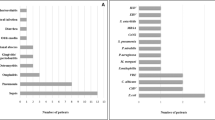Abstract
Two patients with a severe leukocyte adhesion deficiency type 1 (LAD-1) phenotype were analyzed by flow cytometry and functional assays to demonstrate the improper adhesive and phagocytic responses of their leukocytes. A single homozygous defect that involves a missense mutation (c.817G>A) that encodes for a G273R substitution in CD18 was identified in both patients. The adhesion and phagocytosis assays demonstrated the inability of patients’ leukocytes to perform these functions. Expression of the LFA-1 (CD11a/CD18) on the co-transfected HEK 293 cells with the mutated form of CD18 was not detected. Finally, both patients have been treated with immunoglobulin as an adjunctive therapy with positive results. We propose that intravenous immunoglobulin treatment is safe and efficacious in LAD-1 patients before hematopoietic stem cell transplantation and helpful in controlling severe infections. Subcutaneous immunoglobulin appeared to help wound healing in refractory ulcers in these patients.





Similar content being viewed by others
References
Gelfand EW, Ochs HD, Shearer WT. Controversies in IgG replacement therapy in patients with antibody deficiency diseases. J Allergy Clin Immunol. 2013;131(4):1001–5.
Maarschalk-Ellerbroek LJ, Hoepelman IM, Ellerbroek PM. Immunoglobulin treatment in primary antibody deficiency. Int J Antimicrob Agents. 2011;37(5):396–404.
Garcia JM, Espanol T, Gurbindo MD, Casas CC. Update on the treatment of primary immunodeficiencies. Allergol Immunopathol (Madr). 2007;35(5):184–92.
Li L, Jin YY, Cao RM, Chen TX. A novel point mutation in CD18 causing leukocyte adhesion deficiency in a Chinese patient. Chin Med J (Engl). 2010;123(10):1278–82.
Etzioni A. Defects in the leukocyte adhesion cascade. Clin Rev Allergy Immunol. 2010;38(1):54–60.
Campbell ID, Humphries MJ. Integrin structure, activation, and interactions. Cold Spring Harb Perspect Biol. 2011;3(3):a004994.
Luo BH, Carman CV, Springer TA. Structural basis of integrin regulation and signaling. Annu Rev Immunol. 2007;25:619–47.
Tan SM. The leucocyte beta2 (CD18) integrins: the structure, functional regulation and signalling properties. Biosci Rep. 2012;32(3):241–69.
van de Vijver E, Maddalena A, Sanal O, Holland SM, Uzel G, Madkaikar M, et al. Hematologically important mutations: leukocyte adhesion deficiency (first update). Blood Cells Mol Dis. 2012;48(1):53–61.
Hogg N, Patzak I, Willenbrock F. The insider’s guide to leukocyte integrin signalling and function. Nat Rev Immunol. 2011;11(6):416–26.
Etzioni A. Genetic etiologies of leukocyte adhesion defects. Curr Opin Immunol. 2009;21(5):481–6.
Mellouli F, Ksouri H, Barbouche R, Maamer M, Hamed LB, Hmida S, et al. Successful treatment of Fusarium solani ecthyma gangrenosum in a patient affected by leukocyte adhesion deficiency type 1 with granulocytes transfusions. BMC Dermatol. 2010;10:10.
Etzioni A. Leukocyte adhesion deficiencies: molecular basis, clinical findings, and therapeutic options. Adv Exp Med Biol. 2007;601:51–60.
Hogg N, Stewart MP, Scarth SL, Newton R, Shaw JM, Law SK, et al. A novel leukocyte adhesion deficiency caused by expressed but nonfunctional beta2 integrins Mac-1 and LFA-1. J Clin Invest. 1999;103(1):97–106.
Roos D, Law SK. Hematologically important mutations: leukocyte adhesion deficiency. Blood Cells Mol Dis. 2001;27(6):1000–4.
Maravillas-Montero JL, Gillespie PG, Patino-Lopez G, Shaw S, Santos-Argumedo L. Myosin 1c Participates in B Cell cytoskeleton rearrangements, is recruited to the immunologic synapse, and contributes to antigen presentation. J Immunol. 2011;187(6):3053-63.
Theodoridis AA, Eich C, Figdor CG, Steinkasserer A. Infection of dendritic cells with herpes simplex virus type 1 induces rapid degradation of CYTIP, thereby modulating adhesion and migration. Blood. 2011;118(1):107–15.
Qasim W, Cavazzana-Calvo M, Davies EG, Davis J, Duval M, Eames G, et al. Allogeneic hematopoietic stem-cell transplantation for leukocyte adhesion deficiency. Pediatrics. 2009;123(3):836–40.
Zhou MJ, Brown EJ. CR3 (Mac-1, alpha M beta 2, CD11b/CD18) and Fc gamma RIII cooperate in generation of a neutrophil respiratory burst: requirement for Fc gamma RIII and tyrosine phosphorylation. J Cell Biol. 1994;125(6):1407–16.
Nord KM, Pappert AS, Grossman ME. Pyoderma gangrenosum-like lesions in leukocyte adhesion deficiency I treated with intravenous immunoglobulin. Pediatr Dermatol. 2011;28(2):156–61.
Lin JH, Wang KY, Kraft S, Roberts RL. Resolution of warts in association with subcutaneous immunoglobulin in immune deficiency. Pediatr Dermatol. 2009;26(2):155–8.
Nishio N, Ito S, Suzuki H, Isobe K. Antibodies to wounded tissue enhance cutaneous wound healing. Immunology. 2009;128(3):369–80.
Lai A, Hosseini-Tabatabaei A, Hartwell R, Rahmani-Neishaboor E, Kilani RT, Ghahary A. Topical application of aminopeptidase N-neutralizing antibody accelerates wound closure. Mol Cell Biochem. 2013;372(1–2):95–100.
Viard I, Wehrli P, Bullani R, Schneider P, Holler N, Salomon D, et al. Inhibition of toxic epidermal necrolysis by blockade of CD95 with human intravenous immunoglobulin. Science. 1998;282(5388):490–3.
Acknowledgments
We thank to Dr. Héctor Romero-Ramírez and M.Sc. Víctor H. Rosales-García for their help at different stages of this work. Supported by Instituto de Ciencia y Tecnología del Distrito Federal (ICyTDF) (Grant PICSA12-157) and Consejo Nacional de Ciencia y Tecnología (CONACyT) (Grant 153733 awarded to L.S.A.). J.L.M.M. and N.R.A. were supported by doctoral scholarships 203768 and 456878 from CONACyT. L.B.R was the recipient of a doctoral (176353) and postdoctoral (CVU 44813) scholarship from CONACyT.
Conflict of interest
The authors declare that they have no conflict of interest.
Author information
Authors and Affiliations
Corresponding author
Additional information
Marco Yamazaki-Nakashimada and José L. Maravillas-Montero have contributed equally to this work.
Rights and permissions
About this article
Cite this article
Yamazaki-Nakashimada, M., Maravillas-Montero, J.L., Berrón-Ruiz, L. et al. Successful adjunctive immunoglobulin treatment in patients affected by leukocyte adhesion deficiency type 1 (LAD-1). Immunol Res 61, 260–268 (2015). https://doi.org/10.1007/s12026-014-8619-8
Published:
Issue Date:
DOI: https://doi.org/10.1007/s12026-014-8619-8




